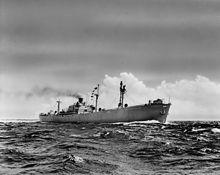Ships
- Sword Line Inc ships owned:
- Eastern Sword built in 1920 at the Uraga Dry Dock Co. Ltd, at Uraga, Kanagawa, Japan. The ship sank after being hit by a torpedo from German submarine U-162 on May 4, 1942.
- Alabama Sword built in 1944 was seized by Allies at Flensburg in 1945, became Empire Lune sold to Sword Line in 1947, in 1951 renamed Texas Sword, sold in 1956. [8]
- Florida Sword built in 1943 as Halsnaes, taken over by Germany renamed Kronenfels for Hansa Line, in 1945 seized by Allies at Copenhagen. Became Empire Roden, sold to Sword Line Inc in 1947. Sold in 1956. [9]
- Silver Sword, built in 1919 by Downey Shipbuilding Company. Sank after a torpedo attack by German submarine U-255 while in Convoy QP 14 coming home to New York City from Archangel, Russia, one crew member was killed. [10]
- Western Sword, built in 1944, ship # V-2651, ID 219567, operated during World War 2 [11] [12] [13]
- Yankee Sword, built in 1921 at New York Shipbuilding Corporation, operated during World War 2. On March 22, 1945, pick up the survivors of the SS Corinth a Keystone Shipping Company Oil Tanker, sunk by Japanese Submarine on March 18. [14]
- Victory Sword, a tanker built in 1910 by Fore River Shipbuilding, operated during World War 2, was deliberately sunk on June 18, 1944, due to its poor condition, to make a breakwater for Normandy landings making Mulberry harbour at Utah Beach. [15] [16]
- MV Oregon Sword, a Type C1 ship, C1-MT-BU1 Cargo, built as Oregon Fir at Albina Engine & Machine Works in Portland OR in 1946. Operated during post World War 2 work and Korean War. Wrecked and a total loss in 1967. [17] [18]
- MV Arizona Sword, Type C1 ship, C1-MT-BU1 Cargo, built at Albina E. & M. in 1945. Sank after collision with Berwindvale on May 4, 1951, in a Cape Cod Canal, she was raised and converted to a barge in 1954. The barge foundered on January 13, 1961. [19] [20] [18]
- MV California Sword, Type C1 ship, C1-MT-BU1 Cargo, built at Albina E. & M. in 1946 as California Redwood, ship Number V-5349, Official Number 248911. [21] [18]
- Coalinga Hills, a T2 tanker, acquired in 1948, sold in 1962, built in 1943 by Marinship, Sausalito, California [22]


- World War II operated ships:
- Liberty Ships:
- SS Pedro Menendez
- SS Cardinal Gibbons built in 1942 at Bethlehem-Fairfield Shipyard. [23] [24]
- Milton J. Foreman, built in 1944 [25]
- George A. Lawson, sank in 1964 as SS Union Atlantic [26] [27]
- Cecil G. Sellers, built in 1944, post war work in 1946, burnt and scrapped 1948 [28]
- Daniel Hiester, built in 1942, post war work in 1946. [29]
- Benjamin H. Bristow, built in 1942, post war work in 1946. [30]
- SS Abner Doubleday, built in 1942 at the Oregon SB Corp. [31]
- Renald Fernald, built in 1943, post war work in 1946, wrecked and scrapped 1963 [32]
- Victory ship:
- SS Carroll Victory, operated post war work in 1948, in 1949 transferred to US Coast Guard. [33]
- Other
- SS Golden Eagle, Type R ship R2-S-BV1, refrigerated cargo ship.
- MV Arizona Pine, post war work in 1946 to 1948, a Type C1 ship, C1-MT-BU1 Cargo, became MV Arizona Sword in 1948. [34] [35]